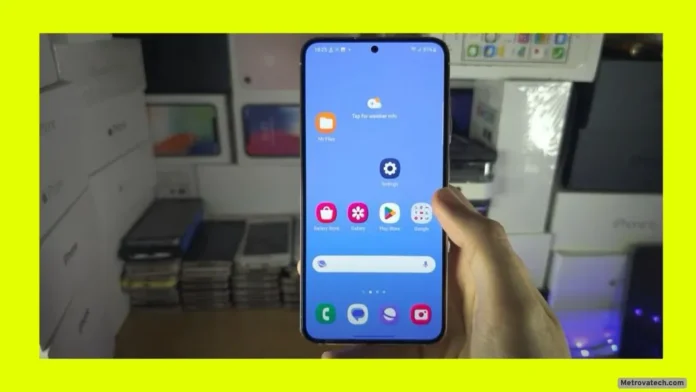If your Android phone’s fingerprint sensor has suddenly stopped working, you’re not alone. Many users, especially after software updates, find themselves frustrated when the fingerprint unlock refuses to respond. This guide focuses on how to fix a fingerprint sensor not working on Android devices, with practical steps you can follow before heading to a service center. Whether you own a Samsung Galaxy S20 FE 5G, another Samsung, a Huawei, or another Android model, these troubleshooting methods can help you get things working again.
Ever thought, “Why is my fingerprint sensor not working on my phone?” Let’s find out what you can do about it, step by step.
Understanding the Fingerprint Sensor Issue on Samsung Galaxy S20 FE 5G
Many Samsung Galaxy S20 FE 5G users reported that after a recent software update, the fingerprint sensor stopped responding. When trying to register a fingerprint, the progress stays at 0%, no matter which finger you use. The sensor does not recognize any input. This is a common problem, not only with Samsung phones but also with many Android devices.
Before you rush to your local service center, it’s good to know that most issues have a software fix. The fingerprint unlock feature is critical for convenience and security. When it fails, it’s easy to think the hardware is faulty, but that’s not always true.
You might wonder, “Why is my fingerprint sensor not working after screen replacement?” or “Could a recent update have caused this?” In many cases, issues start after a big update or when software and settings get mixed up. These steps will help you narrow down the cause and possibly fix it at home.
Key Preparations Before Starting Troubleshooting
Before you try to fix the fingerprint sensor, take a minute to check your phone’s power.
- Make sure your battery is at least 50% charged.
- Keep your phone connected to a charger during all the steps.
Phones may restart multiple times during this process. An unexpected shut-off during a reset could cause software problems.
10 Steps to Fix Fingerprint Sensor Not Working on Android
If you’re thinking, “How to fix a fingerprint sensor not working on Android?” or “How to fix a fingerprint sensor not working on Samsung?” Here’s your complete checklist. Follow these steps in order:
1. Check for Software Updates and Security Patches
- Go to Settings > Software Update or System Update.
- Look for new updates and install them if available.
- Restart your device after updating and test the fingerprint sensor again.
Why? Sometimes a bug in the software update causes sensor issues. Manufacturers often release security patches to fix widespread problems.
2. Run Diagnostic Mode Test (Samsung Only)
Samsung phones have a diagnostic tool for hardware checks.
- Open the phone app and type:
*#0*# - Tap on Sensor, then Fingerprint Test, and choose Normal Scan.
If it shows Pass, your hardware should be fine (but it’s not always 100% certain). If it fails, move to the next step.
3. Restart Your Phone
Sometimes a quick reboot clears out temporary glitches.
- Hold down the power button.
- Tap Restart.
- Let the phone power cycle and try the fingerprint sensor again.
Don’t forget: stay plugged in if possible and keep that battery above 50%.
4. Reset All Settings
Software settings can conflict, especially after updates.
- Open Settings.
- Go to General Management.
- Select Reset.
- Tap Reset all settings.
This resets customization in your system settings but keeps apps and personal data. Your phone will restart. See if things improve.
5. Use Safe Mode to Check Third-Party Apps
Sometimes downloaded apps mess with system features.
- Press and hold the power button and tap Restart.
- As soon as the screen turns off, press and hold the Volume Down button. Release when you see the Samsung logo and Safe mode in the corner.
In Safe mode, only system apps work. Try adding or using your fingerprint here.
- If it works, a third-party app is the problem.
- If it still fails, third-party apps aren’t to blame.
6. Reset App Preferences
Permissions, restrictions, and disabled apps can keep your fingerprint sensor from working.
- Open Settings > Apps.
- Tap the three dots in the upper right.
- Select Reset app preferences.
- Confirm the reset.
This won’t delete apps or data but will clear app permission settings and notification restrictions. Test the sensor again.
7. Wipe Cache Partition and Repair Apps (Samsung Recovery Mode)
System cache corruption can make the fingerprint sensor unresponsive.
Enter Recovery Mode:
- Restart your device.
- As soon as the screen is off, hold Volume Up and Power at the same time.
- When the Samsung logo appears, release both.
Use the volume keys to move up and down. Use the power button to select.
- Select Wipe cache partition and confirm.
- Next, select Repair apps.
These steps clean up old cache files and optimize apps. The device reboots automatically when finished. Test your fingerprint sensor again.
8. Re-Run the Diagnostic Fingerprint Scan
After clearing the cache and repairing apps, run the diagnostic tool again (see Step 2) to check if the result has changed.
- If you now see N/A or “not available,” it suggests the sensor itself isn’t responding and could have a hardware fault.
9. Factory Data Reset
As a last software fix, try a full factory reset. This step deletes all your personal data, so back up your files first.
- Open Settings > General Management > Reset > Factory data reset.
- Read the list of files to be erased and back them up.
- Follow prompts: enter lock pattern and Samsung account password.
- Wait for the process to finish.
Set up the phone as new. Skip unnecessary sign-ins if you want. Try to register your fingerprint again. If it now works, the problem is gone. Back up your data before a factory reset! Photos, contacts, and documents will be lost.
10. Reinstall Software or Consult Service Center
If a factory reset doesn’t fix the fingerprint sensor, the problem could be deeper in the phone’s software (firmware) or related to hardware.
- Reinstalling the phone’s firmware can sometimes help, but most users should get help from a professional or visit an authorized service center.
Here’s what to expect if you visit a service center based on recent experiences:
- Staff will first try reloading software.
- If the issue remains, they’ll do a hardware check. If the sensor isn’t detected, hardware replacement is needed.
- Expect a wait while parts are ordered if not in stock.
This approach covers how to fix a fingerprint sensor not working on Android, works for Samsung and Huawei devices, and applies to similar sensor-related problems on different models.
Insights From the Service Center Experience
If all the above steps fail, your phone might need a fingerprint sensor replacement. Here’s a real-life breakdown from a Samsung authorized service center. This applies to many brands, not just Samsung.
What Will the Service Center Do?
- First, they’ll reinstall your phone’s software and check if the issue remains.
- Next, they’ll perform a hardware diagnosis.
If your fingerprint sensor hardware needs replacing, here’s an example of what you might pay (prices in Indian Rupees):
- Labor Cost: ₹413
- Fingerprint Sensor (Biometric): ₹639 (plus tax, total ₹754)
- Tape WP Back (to reseal phone): ₹170 (plus tax, total ₹138.62)
- Total cost: about ₹1306
Parts may not be in stock, so allow for 2 to 3 days for procurement. Replacement itself usually takes 2 to 3 hours.
Important Tips
- Only visit official or authorized service centers for genuine parts and proper tools.
- Always ask for a cost breakdown before approving the repair.
- Keep your repair receipt for warranty claims or future problems.
- Replacing the fingerprint sensor might void third-party repairs or previous unofficial work and could affect your warranty. Always check.
Conclusion
Getting locked out of your own phone is stressful. However, most fingerprint sensor issues are fixable without hardware work. Here’s a summary to keep in mind for how to fix an Android fingerprint sensor that is not working:
- Try all software fixes first. These include updates, resets, restarting, and wiping the cache.
- Keep your phone’s software up to date to avoid bugs and unexpected conflicts.
- Regularly back up your data, especially before major updates or resets.
- Watch for rogue third-party apps that could interfere with hardware features.
- If fixes don’t work, visit an authorized center for diagnosis and repair for fair pricing and proper repair.
Read also.
- Nothing Phone 3a BIG Update: Private Space, AOD, Macro Camera & 4K 30fps Video Improvements
- Vivo T3 Ultra After New Update: Camera Geekbench Score & UI Experience Explained

Hello! I am Prashant Kumar. Welcome to metrovatech.com! Metrovatech.com serves as the trusted online platform that delivers both mobile updates and smartphone news alongside updates from mobile technology domains.






